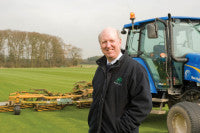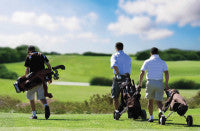Natural grass over synthetics
 Let's start by looking at the sheer aesthetic value of grass. People like seeing it, they like the feel of it, and the smell of freshly cut grass, whether you're mowing your own lawn, playing golf while the course is being cut, or as a greenkeeper cutting the grass as part of your job, is one of the finest smells on earth.
Let's start by looking at the sheer aesthetic value of grass. People like seeing it, they like the feel of it, and the smell of freshly cut grass, whether you're mowing your own lawn, playing golf while the course is being cut, or as a greenkeeper cutting the grass as part of your job, is one of the finest smells on earth.
Real grass makes people happy; it increases their sense of well being and reduces stress levels. Research studies have shown that walking barefoot on grass will lower your heart rate. I cannot imagine anybody feeling the same sense of relaxation sitting in a deck chair on synthetic grass as they do when it's the real thing.
When it comes to the environment, grass wins over synthetics every time. Real plants absorb carbon dioxide and release oxygen. At a time when we're all concerned about our carbon footprint, it's worth remembering that statistics show that 58 square metres of grass - golf course, lawn, parkland, playing field or farmer's pasture - provides enough oxygen for one person for one whole day.
Real grass is an essential part of the eco-system, whereas the synthetic variety, made from oil based compounds, is hugely energy demanding in manufacture.
Real grass is cooling during a heat wave, whereas artificial grass generates heat, and natural grass surfaces absorb water, allowing it to percolate into the aquifer filtering dust and pollutants at the same time. In cities, where run-off is a problem, real grass has an important part to play in sustainable urban drainage systems.
 As a living eco-system, supporting a varied microbial population, real grass absorbs body fluids - spit, blood and sweat for example in sporting situations and dog urine on lawns and parks. The offending substances will be broken down in the soil during a natural self cleaning process that helps keep grassed areas safe for public use. Synthetics require a specific programme of cleaning and disinfection.
As a living eco-system, supporting a varied microbial population, real grass absorbs body fluids - spit, blood and sweat for example in sporting situations and dog urine on lawns and parks. The offending substances will be broken down in the soil during a natural self cleaning process that helps keep grassed areas safe for public use. Synthetics require a specific programme of cleaning and disinfection.
It's no coincidence that all Premier League football matches have to be played on real grass. Athletes find natural surfaces much kinder than synthetics, with less risk of burn when skidding or tackling.
The national debate on sustainability leaves no doubt about the need for natural surfaces with their growing, living eco systems, and comes down strongly in favour of using real grass. The onus is on our industry to produce grass that will put up with the demands made of it in terms of wear, drought, shade and water-logging tolerance.
As an industry, we are constantly looking at breeding new grasses and the management of these grasses. People have to adapt. The industry is reacting and the breeders are producing new grasses all the time. It's what they do, and we must embrace their breeding initiatives.

Just because we've had two exceptionally harsh winters, it doesn't mean that we have to roll over and use synthetics instead of the real thing. If that happens, all our sporting venues, including golf courses will look the same. Golfers hate playing off artificial tees in the winter as it is. They can't wait to get back onto real grass again.
RTF (rhizomatous tall fescue) is incredibly deep rooting, wear resistant and drought tolerant. Anumber of courses in the north west are having great success with RTF turf for the heavy wear areas at the end of pathways, where golfers step off the path with their trolleys and studded boots. Previously golf clubs had to re-turf these areas annually, but the RTF turf is proving resilient enough to weather three of four years in succession.
Our own LT2 Low Maintenance turf, containing Crested Hairgrass, was developed for drought situations and, at the moment, we're developing a more shade tolerant turf - a mixture of Tufted Hairgrass with ryegrass and fescues - which is being trialled in one of London's squares that is subject to shade from trees and buildings. Depending on the results, this new turf should be very useful on shaded golf courses and make a good tees turf.
Looking at football stadiums, where the low light density problem has now been overcome with the introduction of special lighting rigs, a new breed of ryegrass has been developed that will germinate at 3.5 degrees, allowing turf managers to successfully overseed during cold periods and maintain grass cover. Bred by Barenbrug, this new ryegrass is now being used in the majority of football stadiums.
The UK has the best climate in the world for growing grass, and we need to adapt the type of grasses we have so that they can withstand the demands made of them. We also need to adapt maintenance practices to suit these grasses (some might need longer mowing heights) and understand the importance of good soil structure.
We've got improved genetics and improved breeding. Who knows where new biotechnology will lead us? Let's embrace all this new technology to advance further, and leave artificial grass to the hockey pitches and indoor venues where there's really no alternative."
